
21 Sep 2021 HYN Himalayan Yoga Academy
What are Kidney stones? Why Yoga for Kidney Stones? Kidney Stones occur due to metabolic and dietary imbalances in the body and reflect disturbances in the body’s fluid and acid balance. Under different conditions, various substances precipitate out of the urine and form sludge, sediment, gravel, or large stones. Sediments or even stones may pass in the urine, accompanied by severe pain and blood (hematuria). Here we will learn some yogic kriyas for kidney stones.
Types of Kidney Stones
There are three most common forms of kidney stones:
1) Oxalate stones are likely to occur with persistently concentrated urine. Some people assume that a diet including too much oxalic acid-enriched foods is necessary for stone formation. Such foods are spinach, tomatoes, rhubarb, etc. But this is yet to be scientifically proven.
2) Calcium or Phosphate stones are large and staghorn shaped. They may form rapidly under excessively alkaline conditions, or where there is a disturbance of calcium metabolism. This could occur due to an imbalance of the parathyroid glands, excess of calcium food such as milk, or where calcium is being mobilized into the circulation from the bones of the skeleton.
3) Uric acid and urate stones may form due to acidic conditions. For example, consuming a diet too rich in protein sources such as meat, fish, and eggs.
Kidney Pain
Ureteric colic is an excruciatingly severe form of pain. It arises when a stone of relatively large diameter enters the narrow ureter. Then, begins its passage down towards the bladder. This pain radiates from the loin into the groin and may occur in recurrent bouts of two or three hours, or a single bout may continue for twenty –four hours or more. It usually comes on acutely, causing the sufferer to draw up his knees and roll about in agony. It is frequently accompanied by vomiting, profuse sweating, and a great desire to pass urine (strangury), though only small amounts are passed. This is a clear sign that the urinary tract is obstructed.
The acute bout of agonizing renal colic may require a morphine injection for immediate relief and surgery may be indicated in chronic cases where the presence of one or more large stones in the pelvis or the kidney is detected.
Cause of Kidney Stones
Several factors combine to lead to kidney stone formation. They usually occur in the presence of some metabolic disorder and when the urine remains persistently highly concentrated. An unsuitable diet containing excessive meat protein, acid-forming foods such as refined flour and sugar products, too much tea and coffee, chemically preserved and treated foods, and pungent and sour condiments and spices helps to precipitate stones.
An unhealthy diet congests and overloads the liver, and what the liver cannot effectively detoxify and metabolize is passed on to the kidneys. There it may cause inflammation or gravel and stone formation. The kidneys pass as much as possible into the urine, which is usually foul-smelling and highly irritating to the urinary bladder. The long-term effects of this may be inflammation, ulceration, and tumor formation in the bladder.
Other factors contributing to kidney stone formation may include excessive salt or reduced water intake. These leads to a highly concentrated urine obstruction to urinary outflow, and chronic tract infection, leading to stagnant urine. Lack of exercise, especially prolonged immobilization in a recumbent position during convalescence or recovery from injury, is another precipitating cause.
Yogic Management of Kidney Stones
Adopting the following yogic management program and general recommendations can prevent the formation of kidney stones and help remove old stones and urinary sediments. Those who have experienced mild or severe renal pain or have prevented recurrences of the condition can benefit from this approach. However, large stones may present a difficult therapeutic problem, and if yoga fails to provide relief, surgery may become necessary.
- Surya Namaskara: Up to six rounds.
- Asana: Trikonasana, vajrasana, marjari-asana, vyaghrasana, supta vajrasana, ushtrasana, shashank bhujangasana, shalabasana, ardha matshyendrasana, naukasana, ardha padma paschimottanasana, ardha padma halasana, chakrasana, merudandasana, hamsasana, mayurasana, koormasana, dwi pada sirsana, tadasana, triyaka tadasana, kati chakrasana, udarakarshanasana.
- Pranayama: Bhastrika with bandhas.
- Mudra and bandha: Pashinee mudra and yoga mudra, moola bandha, Vajroli mudra, uddiyana bandha.
- Shatkarma: Agnisar Kriya or Naulil is practiced daily. Shankhaprakshalana in an ashram environment. Laghoo shankhaprakshalana once a week.
- Relaxation: Yoga Nidra and abdominal breathe awareness.
- Meditation: Ajapa japa, nada yoga.
- Diet: A fresh wholesome natural diet is recommended. Fruit, juices, and lightly cooked succulent vegetables are recommended to alkalinize the urine. Avoid or reduce the intake of meat, eggs, fish, and milk products as they produce uric acid and waste in high concentrations. Avoid acid-forming foods and highly refined flour and sugar products such as cakes, sweets, biscuits, etc. Restrict the intake of tomatoes and spinach, which are high in oxalic acid. Decrease the intake of salt. Try to drink at least four liters of water per day, especially in the summer months. It is claimed that pears can dissolve kidney stones if up to a dozen are consumed per day.
- Fasting: In conjunction with increased water intake fasting is highly recommended in order to flush , cleanse, and purify a sluggish urinary system.
Further Recommendation
- A short walk each day is recommended, particularly after the evening meal.
- Try to get some outdoor exercise at least once or twice a week.
- Parsley tea is said to be very beneficial. Take a small glassful every three hours.
